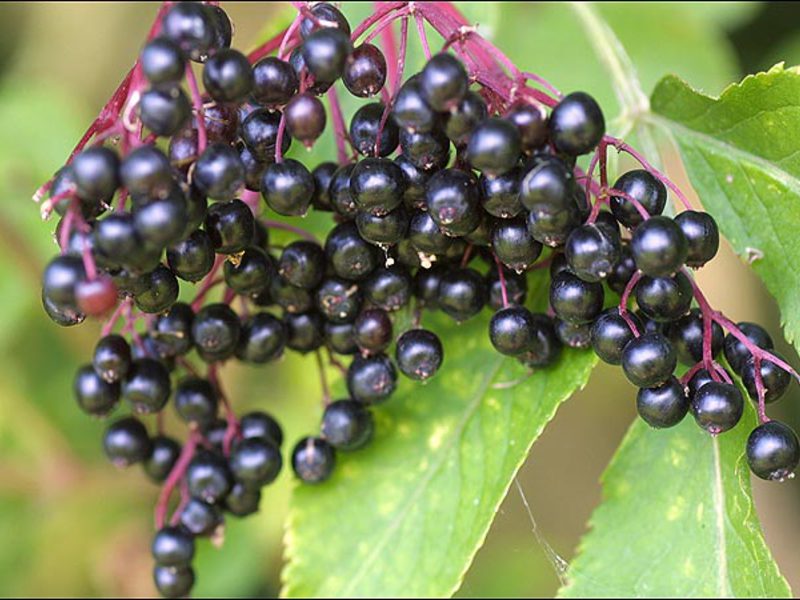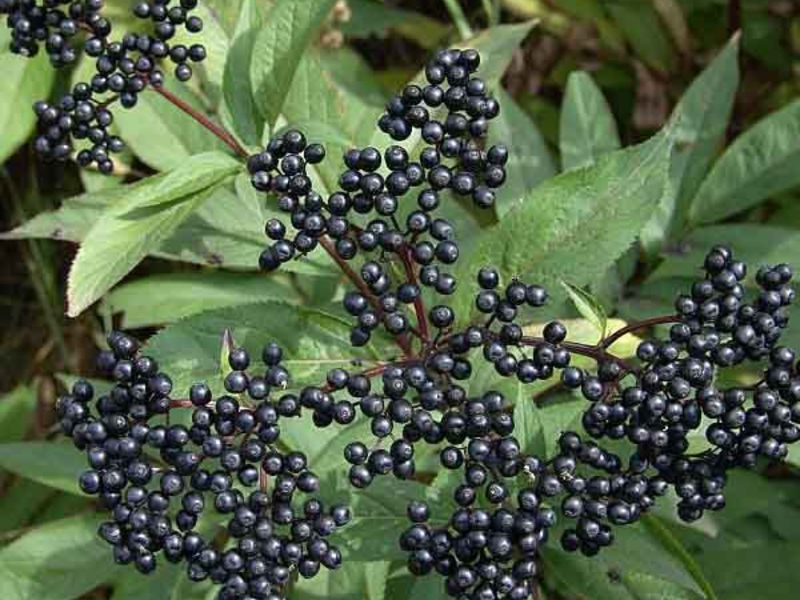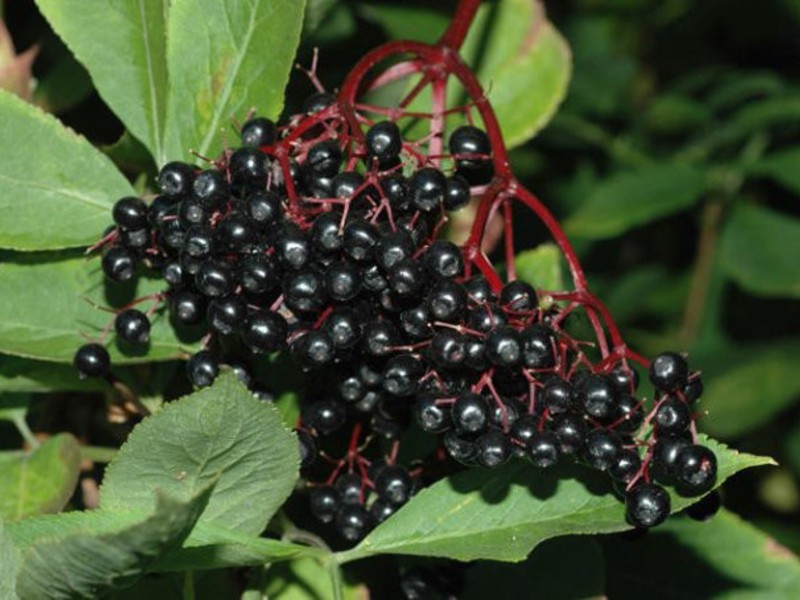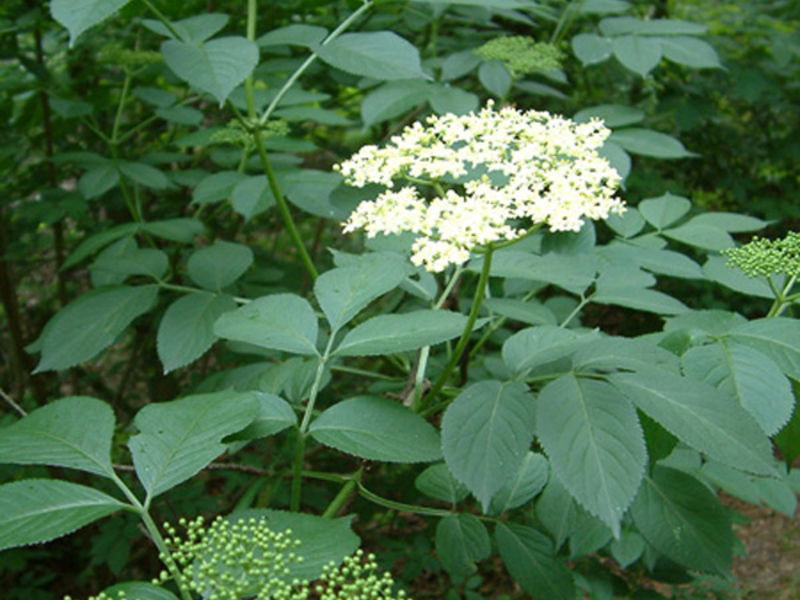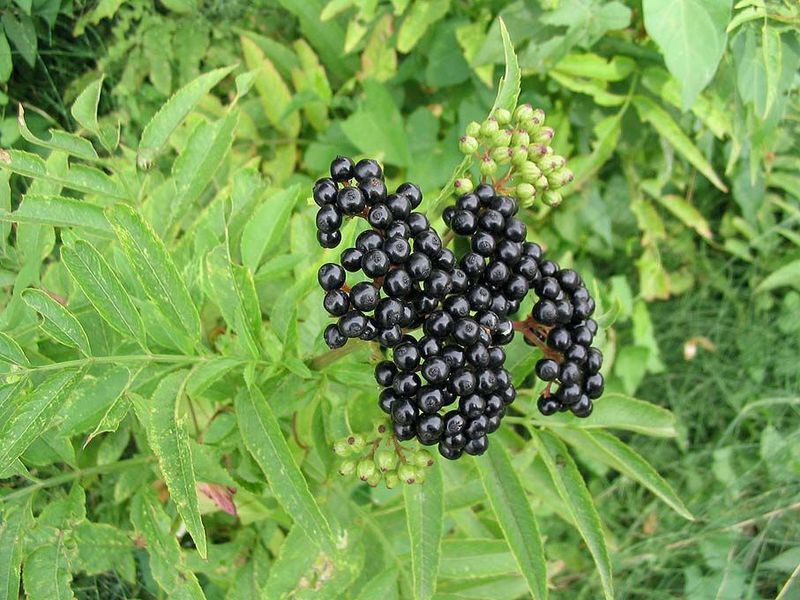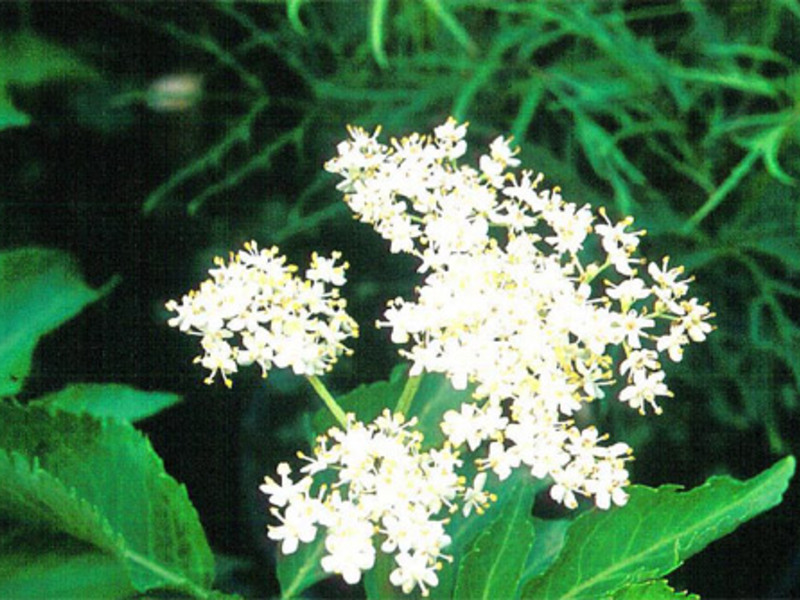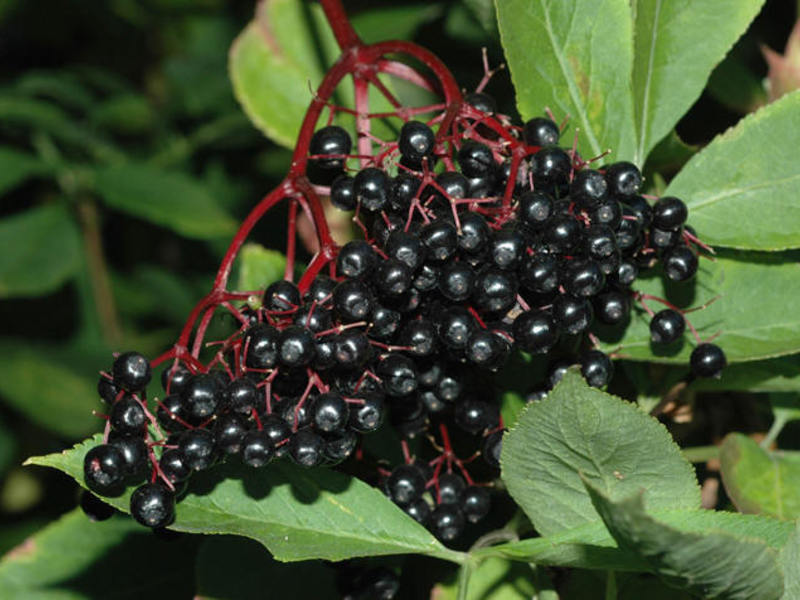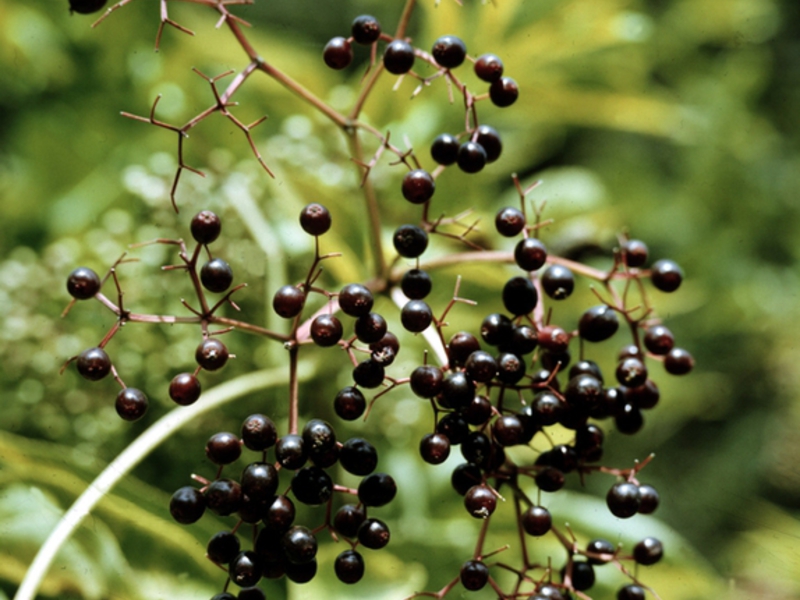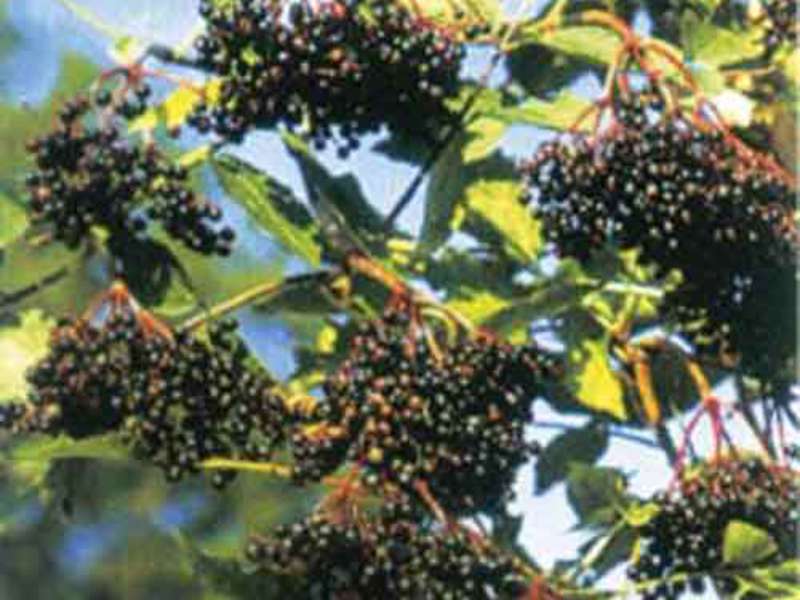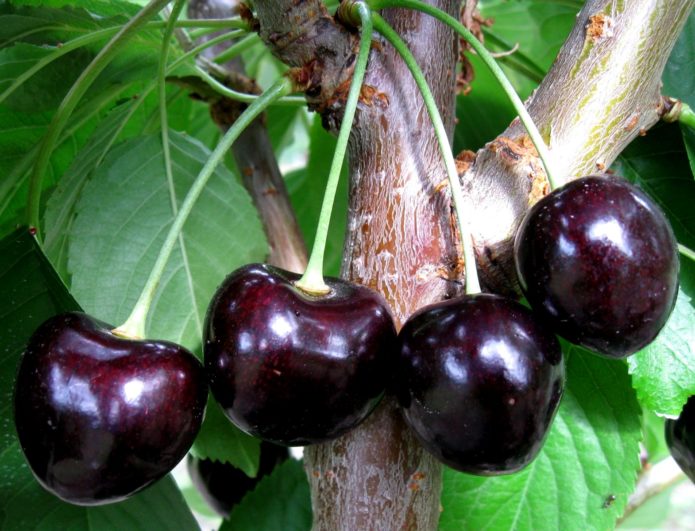Almost all plants are used in folk recipes: from fruits and seeds to roots and leaves. They are used in pharmacology, folk medicine, cooking, as a decorative decoration and in other fields. The black elderberry is a prime example of this versatile use.
Content
Black elderberry: general facts
The black elderberry is a shrub of the same genus, belonging to the Adoksov family. Her height can reach 2-6 meters, some specimens reach 10. Leaves are large, reach 30 cm and consist of 3-7 leaves. Flowers are small, up to 8 mm, have a yellowish color, some specimens are white. They are collected in inflorescences 10-25 cm in diameter. Elderberry blooms in late spring and early summer. The fruits are black-purple in color, the pulp is red, the berries are small, have 2-4 seeds. The fruits ripen in late summer and early autumn. Has an unpleasant smell, which helps to escape from animals.
In almost all parts of the black elderberry contains useful substances, which are used in medicine and folk recipes:
- The roots contain tannins and saponins;
- The bark contains essential oil, tannins and pectin substances, organic acids and sugars;
- The leaves contain ascorbic acid, carotene, resins, essential oil (in small amounts);
- Flowers are rich in organic acids, glucose, tannins, mineral salts and resins, there is also a little essential oil;
- The seeds contain fatty oil;
- In fruits - acids and amino acids, sugars, carotene, tannins.
There are 73 calories per 100 grams of elderberries, 11.5 grams of carbohydrates and 0.5 grams of proteins and fats.
Distribution and breeding of elderberry
Where does black elderberry grow? You can meet her mainly in subtropics and temperate climates... You can meet bushes:
 In Europe, in the mountains of the Middle Caucasus, in the CIS countries;
In Europe, in the mountains of the Middle Caucasus, in the CIS countries;- In North Africa (Tunisia and Algeria);
- In Asian countries located in a temperate climate (Iran and Turkey);
- In New Zealand, the Azores and Madeira.
In Russia, the black elderberry grows in the south of the European part, as well as in some southern regions of Siberia. It does not grow only in Central and South Africa, as well as in South America. The plant chooses forests, forest edges, meadows, wastelands, roads, cemeteries and dumps. It is easy to find it in thickets of nettles and quinoa.
Growing elderberries in gardens
Many grow the plant in gardens and vegetable gardens. For decorative purposes, special varieties are usually used, for example, "Eva" ("Black lace") with black-pink leaves and pinkish flowers.
In order for the bushes to take root well, it is recommended to plant them on the sunny side and water abundantly. If necessary, and for stronger growth in the summer, you can add fertilizers, in early spring it is recommended to carry out complementary foods. When planting young bushes, it is recommended to use a mixture of part of the torus, part of the sand and two parts of humus and turf.
Elderberry reproduces in several ways:
- Seeds: they are planted in autumn, sprouts appear by spring, which are transplanted after a year to a permanent place.
- Cuttings: In the summer, a green cutting is cut from the bush, the cut is processed and rooted.
- Bypass: This is the most time consuming and efficient solution. Green shoots are bent to the ground and laid in furrows, covering them with earth. After a year, the shoots can be carefully separated from the main bush and transplanted.
Collection and storage of elderberry
in folk medicine mainly apply flowers and fruits.
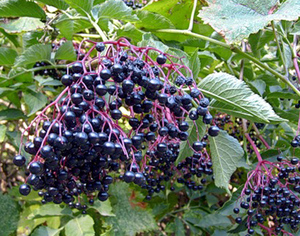 Strong flowers without damaged parts are harvested in May and June, when they are fully blooming. Then they are dried in a dark but well-ventilated place: on balconies, attics, under awnings. You can also use dryers, setting the temperature to 35 degrees. After a few days, when the flowers are completely dry, they are separated from the pedicels and rubbed through a large sieve. They can be stored for up to 2 years.
Strong flowers without damaged parts are harvested in May and June, when they are fully blooming. Then they are dried in a dark but well-ventilated place: on balconies, attics, under awnings. You can also use dryers, setting the temperature to 35 degrees. After a few days, when the flowers are completely dry, they are separated from the pedicels and rubbed through a large sieve. They can be stored for up to 2 years.- The fruits are harvested in late August and early September. They are dried at a temperature of 60 degrees in dryers or ovens, if it's sunny outside, you can arrange the berries in one row outside. After they are also separated from the stalks. The shelf life of berries is short - only half a year.
- If the fruits are needed for jam and jam, you do not need to dry the berries. They are harvested before processing and do not keep for more than 2 days, otherwise the fruits will begin to dry out and rot.
- The roots of the plant are harvested at the end of autumn, after drying, they are ground into powder. You can also use bark from 2 year old shrubs. It is ripped off in early spring, until the elderberry begins to wake up, separated from the wood and dried at a temperature of 65-70 degrees. Both parts can be stored for up to 3 years.
You need to store elderberry in a dry and dark place, with a constant flow of air. The workpieces are extremely capricious, easily mold in the presence of moisture and dampness. They must be constantly checked and spoiled ones removed.
Beneficial features
There is a legend that rather succinctly describes the healing properties of elderberry. Once, many centuries ago, a prince got lost on a hunt and came across a hut on the porch of which an old man was sitting and crying. When the prince asked about the reason for his sadness, the old man complained that his father beat him because he carelessly carried grandfather from the bench to the stove and dropped him.
Entering the hut, the prince saw two even older men, who, nevertheless, were in full health. They said that the secret of their longevity is in the berries of the elder, the bush of which grows near their yard.
Elderberry is used to treat a number of diseases:
- For the normalization of metabolic processes and for violations of the gastrointestinal tract, as a diuretic and for constipation;
- For illnesses with influenza, viral infections, migraines, fever, as a diaphoretic and expectorant with a strong cough of a number of diseases;
- It can be used for diseases of the female reproductive system;
- It is used for skin rashes, abscesses, conjunctivitis;
- Recommended as an anesthetic and sedative, to strengthen and enhance immunity;
- Elderberry seed oil helps with gout, infusion of the root cleanses the kidneys, and a decoction of the bark will help to cope with the bladder.
In addition, the plant is used for:
- Dyeing in dark silk and cotton tones;
- As an active additive in cosmetics;
- Branches and bark perfectly drive away ticks and pests, small rodents;
- When preparing jam, jam, syrup, compote, wine, it is often added to tea and baked goods as a natural dye. Juice can be squeezed out of the berries, but it should be used carefully: no more than 200 ml per day and mixed in equal proportions with honey. They drink it half an hour before meals.
Several recipes
Elderberry is used in the form of infusions and decoctions.
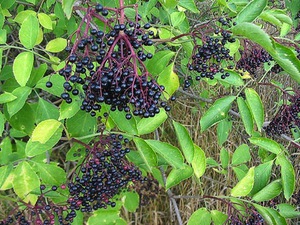 For constipation: pour a tablespoon of berries with a glass of cold water and leave for 2 hours, then filter and take once a day.
For constipation: pour a tablespoon of berries with a glass of cold water and leave for 2 hours, then filter and take once a day.- In the treatment of colds and flu: 1-2 tablespoons of flowers are poured with a glass of boiling water, infused for 20 minutes, filtered and removed to a cool place. It is necessary to take ¼ glass 15-20 minutes before meals. You can also gargle with this infusion.
- For edema: 3 tablespoons of elderberry root are poured with a liter of boiling water, brought to a boil and boiled until the water is halved.Take an infusion of 100-150 grams before meals.
- With edema or inflammation of the kidneys: a tablespoon of elderberry bark is poured with half a liter of boiling water and left overnight in a thermos (about 5-6 hours). Consume 100 ml 5 times a day at regular intervals.
- With diabetes mellitus: a tablespoon of elderberry root is poured with a glass of boiling water, boiled for half an hour over low heat, then cooled and filtered. Add plain water to a glass and consume it before meals.
- For stomatitis and laryngitis: 5 tablespoons of flowers are poured with a liter of boiling water and boiled for 5 minutes, then left to infuse for 45 minutes. Strain and use for mouthwash.
Also elderberry can be used externally:
- For rheumatism, gout and ear pains: mix equal amounts of chamomile and elderberry flowers, tied in a gauze bag, scalded with boiling water and applied to the sore spot.
- For inflammation, diaper rash and burns: young leaves are boiled in milk for 5 minutes, then applied to the skin.
Contraindications and side effects
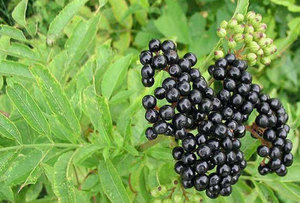 It must be remembered that the elderberry plant is poisonous. A weak poison is found in the entire bush, except for the pulp of berries and flowers, but it is still present in the seeds. When using berries, they are needed from the pulp.
It must be remembered that the elderberry plant is poisonous. A weak poison is found in the entire bush, except for the pulp of berries and flowers, but it is still present in the seeds. When using berries, they are needed from the pulp.
Elderberry treatment can be carried out only after consulting a doctor and in strict accordance with his recommendations. The plant is contraindicated:
- For allergies and individual intolerance;
- During pregnancy and while breastfeeding;
- In the presence of diabetes insipidus and stomach ulcers;
- Children under 12 years old.
Black elderberry also has a number of side effects that can occur with excessive use of the plant. Most often it is vomiting, nausea and other symptoms of poisoning. In this case, you must urgently consult a doctor. It is worth remembering that elderberry is especially dangerous for animals - they should not be allowed to consume it.
Important
The relative of the black elderberry, the red elderberry, is extremely dangerous in any form. It is very poisonous, but both species can be distinguished only at the very beginning of their maturation. If you are unsure, do not pick berries in new locations. Herbaceous elderberry can do no less harm.
In no case you can not eat unripe berries - they can cause severe poisoning.
Output
Black elderberry is a commonly used folk medicine that helps to cope with a variety of diseases. It can be used fresh or dry, as well as dried for future use or bought at the pharmacy. It must be remembered that the plant is poisonous, and therefore its use as a medicine must be agreed with the doctor.
